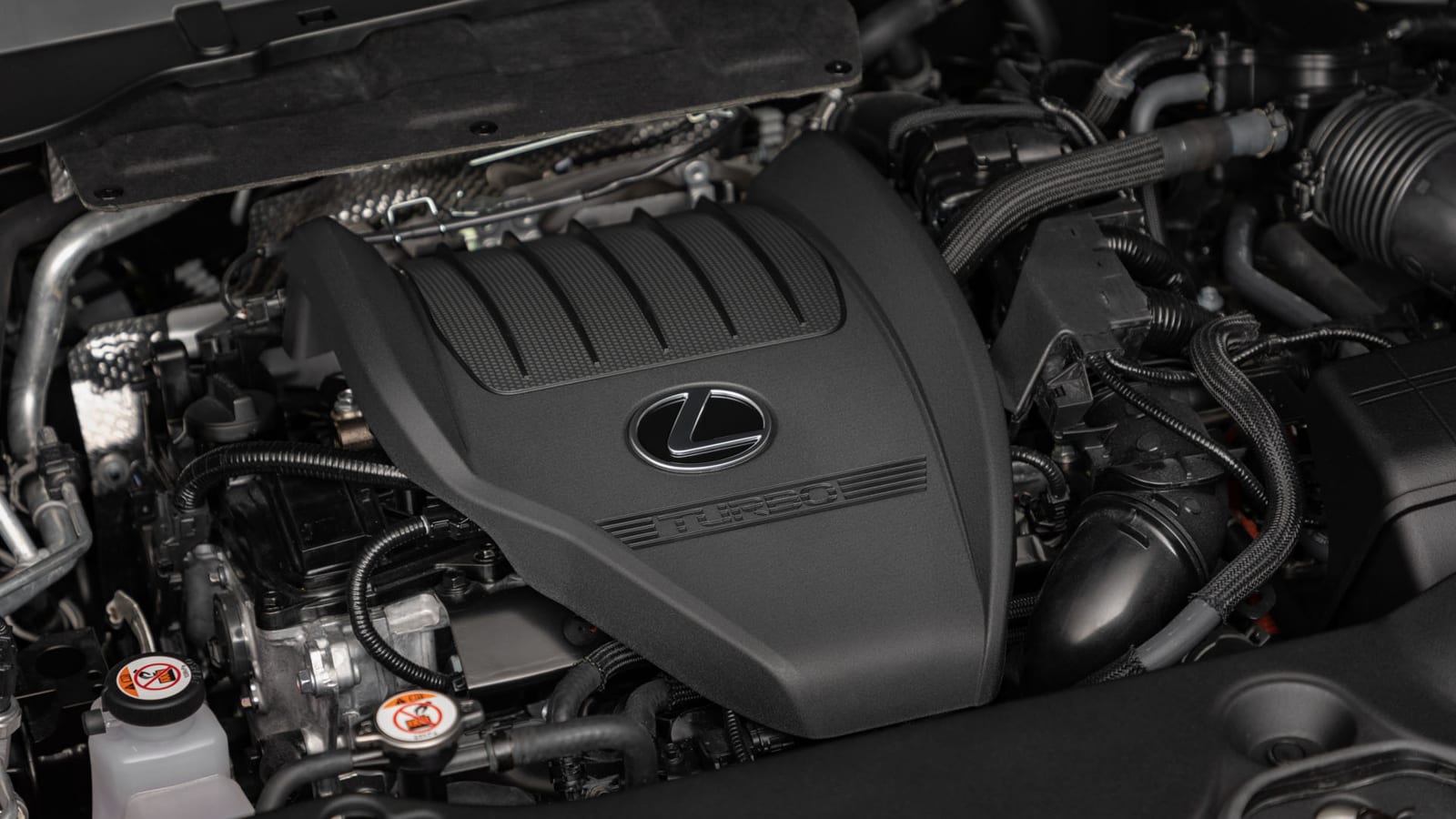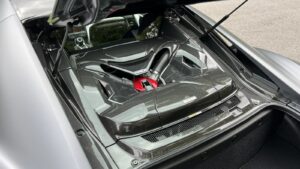The 2024 Lexus GX finally brings the luxury off-roader up-to-date. And it does so in a boxy, rugged wrapper that makes comparisons to the 2024 Land Rover Defender, another luxury off-roader of similar size and capability. So we figured, let’s make that comparison. We’ve looked at all the specifications available for the two SUVs to see how they stack up.


Engines and Transmissions
The GX keeps things simple under the hood with a single powertrain. It has a twin-turbocharged 3.4-liter V6 hybrid making 340 horsepower and 479 pound-feet of torque. That horsepower number only tops the Defender’s four-cylinder engine, but the GX has the torque advantage even against the Defender’s mighty V8 option. The GX’s V6 is paired with a 10-speed automatic and full-time four-wheel drive. Full fuel economy numbers haven’t been given, but Toyota is expecting 17 mpg combined. Unfortunately, that fuel economy is worse than all the Defender powertrains except the V8.
As alluded to, the Defender is available with three main engines, an inline-four, inline-six and V8. The closest competitors to the GX will be the regular 110 four-door and the longer 130 four-door. The 110 can be had with the turbo 2.0L four-cylinder making 296 horsepower and 295 pound-feet of torque; the turbo mild-hybrid 3.0L six-cylinder making 395 horsepower and 405 pound-feet; or the supercharged 5.0L V8 making 518 horsepower and 461 pound-feet. The 130 gets two versions of the six-cylinder, one making 296 horsepower and 347 pound-feet and one making 395 horsepower and 405 pound-feet. The V8 is also available but just with 493 horsepower and 461 pound-feet of torque. All of the engines get an eight-speed automatic and full-time four-wheel drive. The four-cylinder 110 gets 18 mpg combined, the six gets 20 and the V8 manages just 16. Both 130 six-cylinder powertrains return 19 mpg combined, and the V8 doesn’t have numbers yet.


Towing and Cargo
Towing capacity is pretty straightforward. The Lexus has a maximum capacity of 8,000 pounds, and the Land Rover tops it by 200 pounds more. Some trim levels of both SUVs have lower towing capacity, depending on the configuration.
As for cargo space, Lexus hasn’t shared details. It is available with up to three rows of seating and room for seven passengers. The 110 has similar seating available, and the 130 ups the ante with a three-across third row. And we’ve found that the 130’s third row is genuinely usable by adults. The 110’s official cargo numbers range from 35.4 cubic feet with the second-row seats up, to 70.4 with them folded, though we’ve found it’s more spacious than the numbers say. As for the 130, it has 15.3 cubic feet behind the third row, and space increases to 80.9 with all the seats down.


Suspension, Chassis and Off-Road Features
The new GX features the same body-on-frame platform as the Lexus LX, Toyota Sequoia and others. It also has double-wishbone front suspension and a multi-link rear. Toyota didn’t give any other specifics about the rear, so we’re presuming it’s still a live rear axle, similar to the Sequoia and Tundra. Lexus also skips any kind of air suspension for conventional suspension, and adaptive shocks as well as an electronically controlled version of Toyota’s trick Kinetic Dynamic Suspension (sort of active anti-roll bars that can allow for additional articulation).
The Land Rover on the other hand has a unibody chassis and fully independent suspension. The base models have fixed, steel, coil-spring suspension, but air suspension with adjustable ride height and firmness is available on higher trims.
Without adjustable ride height, the Lexus can’t change ground clearance or it’s approach, departure and breakover angles. Lexus didn’t give ground clearance, but it did give the other specs. The approach angle is 26 degrees on all versions. Breakover is 23 degrees on all but the Overtrail, which hits 24 degrees. The departure angle is 21 degrees on the top Luxury GXs, 22 on Overtrail, and 23 on the base Premium trims. Land Rover doesn’t provide quite the exact same off-road angle measurements, but both the 110 and 130 beat the the GX on approach and departure angles with fixed suspension and at the default ride height with air suspension. The approach angle for both is between 30 and 31 degrees, and the standard departure angle for the 110 is nearly 38 degrees and 24.5 for the 130.
As for off-road goodies, the GX is most capable in Overtrail guise. It fits 18-inch wheels with 33-inch tires, an electronic locking rear differential, adjustable drive modes, surround-view cameras, hill descent control, Crawl Control (Toyota’s off-road cruise control system) and the Electronic Kinetic Dynamic Suspension. The Defender is available with many similar features such as adjustable drive modes, surround-view cameras, hill descent control, All-Terrain Progress Control (Land Rover’s off-road cruise control) and Wade Sensing (a feature that detects how deep the vehicle is).
Related Video:
.embed-container { position: relative; padding-bottom: 56.25%; height: 0; overflow: hidden; max-width: 100%; } .embed-container iframe, .embed-container object, .embed-container embed { position: absolute; top: 0; left: 0; width: 100%; height: 100%; }
- SEO Powered Content & PR Distribution. Get Amplified Today.
- EVM Finance. Unified Interface for Decentralized Finance. Access Here.
- Quantum Media Group. IR/PR Amplified. Access Here.
- PlatoAiStream. Web3 Data Intelligence. Knowledge Amplified. Access Here.
- Source: https://www.autoblog.com/2023/06/08/2024-lexus-gx-land-rover-defender-specs-comparison/
- :has
- :is
- $UP
- 000
- 1
- 10
- 11
- 110
- 12
- 13
- 14
- 15%
- 16
- 17
- 20
- 200
- 2024
- 22
- 23
- 24
- 26
- 30
- 31
- 7
- 70
- 8
- 80
- 9
- a
- About
- Absolute
- active
- Additional
- adjustable
- ADvantage
- against
- AIR
- All
- allow
- also
- an
- and
- Another
- any
- approach
- AS
- At
- Automatic
- available
- bars
- base
- BE
- been
- behind
- between
- both
- Brings
- but
- by
- cameras
- CAN
- capable
- Capacity
- Cargo
- change
- chassis
- combined
- comparison
- competitors
- Configuration
- control
- controlled
- conventional
- cruise
- deep
- Default
- Depending
- details
- DID
- does
- doesn
- down
- drive
- dynamic
- economy
- Electronic
- electronically
- embed
- Engine
- Engines
- Even
- Except
- expecting
- Feature
- Features
- Feet
- figured
- Finally
- fixed
- For
- found
- from
- front
- Fuel
- full
- fully
- get
- Give
- given
- Ground
- had
- hand
- Have
- height
- Hidden
- higher
- Hits
- hood
- How
- HTTPS
- in
- Increases
- independent
- IT
- jpg
- just
- Kind
- Land
- land rover
- left
- levels
- lexus
- live
- longer
- looked
- lower
- Luxury
- Main
- make
- MAKES
- Making
- manages
- many
- max-width
- maximum
- measurements
- mighty
- models
- modes
- more
- most
- nearly
- New
- number
- numbers
- object
- of
- official
- on
- ONE
- only
- Option
- or
- Other
- Others
- paired
- platform
- plato
- Plato Data Intelligence
- PlatoData
- PoS
- position
- pounds
- Premium
- pretty
- Progress
- provide
- range
- RE
- regular
- relative
- return
- Ride
- Room
- rover
- ROW
- s
- same
- SEC
- see
- seven
- shared
- similar
- Simple
- single
- SIX
- Size
- So
- some
- Space
- specifications
- specs
- stack
- standard
- steel
- Still
- straightforward
- such
- suspension
- SUVs
- system
- than
- that
- The
- Them
- they
- things
- Third
- though?
- three
- tires
- to
- top
- Tops
- toyota
- two
- under
- unfortunately
- up-to-date
- UPS
- usable
- Ve
- vehicle
- version
- Video
- we
- WELL
- which
- will
- with
- worse
- yet
- zephyrnet












